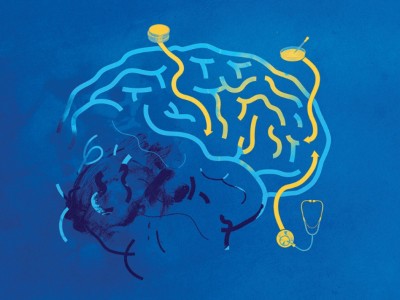Alzheimer’s disease and protein imbalance in middle age.
Even though Alzheimer’s disease is the most prevalent form of dementia, it is not a natural part of ageing and affects an increasing number of people.
The hunt for early disease markers is ongoing because early diagnosis and treatments help both dementia patients and their carers.

Now, 32 proteins have been related to the later development of Alzheimer’s disease in middle-aged persons after a lengthy investigation. The researchers advise more investigation into these proteins as potential indicators of Alzheimer’s disease.
The most prevalent type of dementia, Alzheimer’s disease, affects more than 6 million people in the United States. According to the World Health Organisation, Alzheimer’s disease is to blame for 70 percent of the 55 million cases of dementia globally.
Alzheimer’s symptoms can be treated, but there is currently no known cure for the condition. Trials of new drugs, however, are encouraging.
Donanemab, lecanemab, and aducanumab, novel monoclonal antibody medications that remove amyloid proteins from the brain, appear in clinical trials to delay the onset of disease symptoms.
Early diagnosis is essential to successful therapy because studies have shown that these drugs work best when administered during the early stages of the disease. Donanemab trial data recently made public indicate that the medication dramatically slows the clinical course of Alzheimer’s when taken soon after symptoms first occur.
Proteins that are connected to the later development of Alzheimer’s have been found in a recent study of adults between the ages of 45 and 65.
What is the disease Alzheimer’s?
A form of dementia that progresses is Alzheimer’s disease. A condition that adversely impacts memory, thinking, and behavior is referred to as dementia. The modifications make daily life more difficult. There are numerous possible causes of dementia, including diseases and brain traumas. Sometimes there is no known cause.
The Alzheimer’s Association estimates that 60 to 80 percent of dementia cases are caused by Alzheimer’s disease. The condition is typically diagnosed in patients over the age of 65. Alzheimer’s disease is typically described as having an “early onset” or “younger onset” if it is discovered earlier.
Alzheimer’s has no known cure, but some medications can halt the disease’s growth.
A 32 protein biomarker imbalance
The goal of this study was to find proteins that are improperly expressed in middle-aged persons (defined as those between the ages of 45 and 65) who later experience dementia.
Researchers collected blood samples from 10,981 individuals with a mean age of 60 at the beginning of the trial, between 1993 and 1995. Then, using the blood samples, they examined more than 4,800 plasma proteins.
1,874 patients (17%) had dementia diagnoses over the course of the 25-year follow-up period.
32 plasma proteins were discovered by the researchers to be linked to dementia risk. GDF15, a protein involved in inflammation, oxidative stress, and metabolic and immunoregulatory regulation, showed the highest correlation.
They next looked into whether proteins were linked to dementia risk in the short-term (within 15 years of protein measurement) and long-term (beyond 15 years following protein measurement).
Seven midlife proteins, including GDF15 and others related in immunology, growth factor binding, protein breakdown, and nerve and synaptic function, were linked to a higher chance of developing near-term dementia.
Along with six other proteins that were not prominent at the 15-year mark, GDF15 was also linked to a risk of long-term dementia, indicating that the molecular pathways underlying the risk of dementia evolve with time.
Early warning signs of Alzheimer’s disease
The proteins were also discovered in some of the brain tissue. However, GDF15, which was linked to both short- and long-term risks of dementia, was not found by the researchers in the brain tissue.
They contend that rather than being an Alzheimer’s disease-specific protein, it is connected to the neuroinflammation that is linked to aging-related disease.
However, they think they have “identified several pathway-specific plasma proteins that may be relevant in the earliest phase of Alzheimer’s and related dementias.” The researchers did not discover any direct causal links between proteins and Alzheimer’s.
Do new Alzheimer’s tests result from this?
“Although the dementia-associated proteins alone did not provide a highly accurate prediction of 25-year dementia risk, these proteins, in combination, did add modest predictive value to a group of demographic and clinical variables which are themselves strong predictors of dementia risk,” the study’s authors stated.
The proteins that have been discovered, according to the researchers, ought to serve as the starting point for additional study because they might be dementia risk factors.
Additionally, they assert that their findings might shed light on pertinent biological pathways and make it easier to uncover illness early signs and molecular triggers.
Therefore, with more study, these proteins might be helpful in determining a person’s risk of dementia. We will have to wait and see if they contribute to the development of new dementia diagnostic tests.
REFERENCES:
- https://www.medicalnewstoday.com/articles/protein-imbalance-during-middle-age-linked-to-dementia-risk-25-years-later
- https://www.nature.com/articles/d41586-023-02374-2
- https://science.slashdot.org/story/23/07/21/1719237/dementia-risk-linked-to-blood-protein-imbalance-in-middle-age
For Alzheimer’s disease medications that have been suggested by doctors worldwide are available here https://mygenericpharmacy.com/index.php?therapy=31